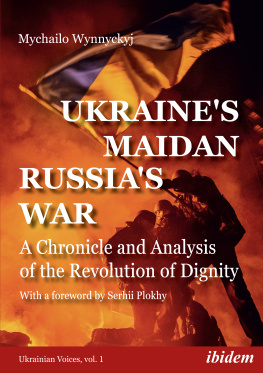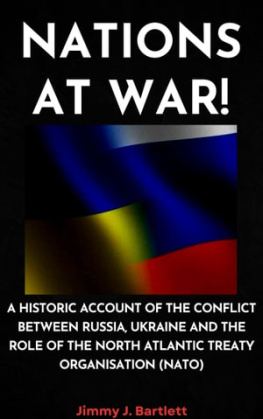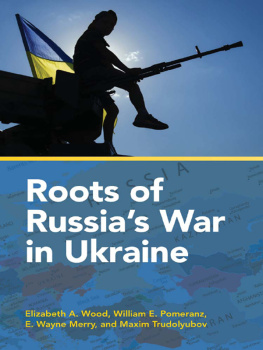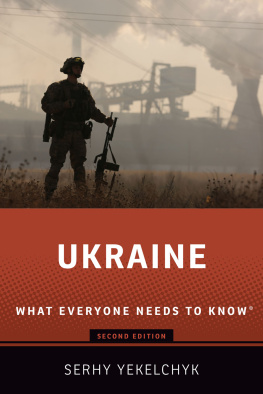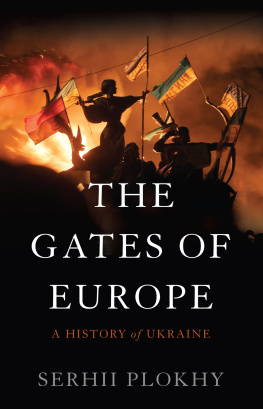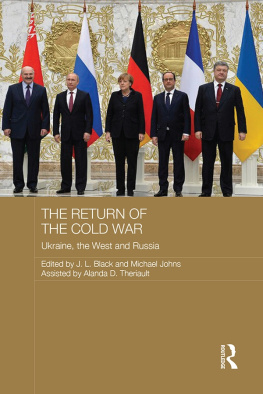
Also by GORDON M. HAHN
The Caucasus Emirate Mujahedin: Global Jihadism in Russias North Caucasus and Beyond
(McFarland, 2014)
Ukraine Over the Edge
Russia, the West and the New Cold War
GORDON M. HAHN

McFarland & Company, Inc., Publishers
Jefferson, North Carolina
They sow the wind and reap the whirlwind.
The stalk has no head; it will produce no flour.
Were it to yield grain, foreigners would swallow it up.Hosea 8:7
To the memory
of my late loving wife,
Marina Markovna Stegantseva-Hahn
(April 1, 1966June 23, 2015)
Preface
As I read, listened and watched Western sources on the events surrounding the mass demonstrations on central square in Kiev during winter 20132014, a sense of dj vu became undeniable. Having studied the nature of terrorism in Russias North Caucasus, the causes and course of the August 2008 Georgian-Russian war, and other events involving Russia, I had seen a pattern of misrepresentation of these events by most Western, especially American, media, academia and government sources. There was a clear sense that this pattern was being repeated with regard to the events on the Maidan. Hence, I decided to investigate matters for myself and have come to a distinctly different conclusion regarding them than that imparted to the Western public.
Two years after the Maidan revolution of dignity, it was already clear that the Western-backed overthrow of Ukrainian President Viktor Yanukovich was not entirely a revolution and was ultimately in vain regardless of how one conceptualizes the events surrounding the fall-winter 20132014 demonstrations and violence on Kievs Maidan. The movement was based intially on middle class opposition to corruption and soft authoritarianism and support for European integration. Ultimately, the nascent pro-democratic revolution was hijacked by neofascist elements that infiltrated the Maidan protests, overthrew the government, and then were themselves superseded by several key oligarchs, who always have thrived under the postSoviet ancien regime. Thus, corruption and criminality have increased rather than decreased, European integration has stalled, and authoritarianism is not just in the corridors of power but on the streets under the yoke of roaming bands of neofascist groups seeking to foment a second, truly national revolution.
Despite the all-too-numerous adepts of democratization and democratic transition, this is not the first, nor is it likely to be the last time when the West has misunderstood processes it has hoped for, encouraged, and often funded and helped to organize. The Arab Spring is only the most recent set of cases in point. Predictably, that springs various revolutions became an Islamist winter spread across parts of the Middle East and North Africa, except in Egyptwhere a counterrevolution returned the status quo ante.
Similarly, in 1991 the adepts of democratic transitions or transitology got it wrong. Few postSoviet states became democracies because the democratic revolution that overthrew the reformist late Soviet regime of Mikhail Gorbachevs perestroika was assumed to be a revolution from below led by societal opposition forces bent on living in a democracy. This was true in the Baltic republics, but in most cases the elements of democratic revolution from below were subsumed by a mix of less civil state bureaucratled revolutions from above and nationalist-led revolutions from below. In Russia, the revolution was largely one led from above by the Russian President Boris Yeltsin and the Russian state apparatus against the partially reformed but crumbling central Soviet state and regime. In Central Asia and elsewhere, there was simply a change of signboards, rebranding for still very authoritarian regimes. The partial exception is Kyrgyzstans tulip revolutions and counterrevolutions, which also had strong elements from above. Thus, it is no surprise that both Ukraines 2004 Orange revolution, as I noted at the time, and the 20132014 Maidan revolution of dignity, as I predicted, proved to be something less than the democratic revolutions transitologists hailed.
In addition to elements of revolution from below, the Maidan revolt also has elements of revolution from above led by some state officials and state-tied oligarchs. Moreover, the revolution from below was under considerable influence from national chauvinist, ultranationalist, and neofascist groups. The Maidan ultranationalist-oligarchic regime now has little popular support and few accomplishments in democratization, and is little different from the previous, except for a marked increase in western Ukrainian neofascism (both in the corridors of power and on the streets) and a near catastrophic economy. Revolutions are indeed unwieldly things, not very manageable once unleashed.
The international geopolitical consequences have been even more deleterious. A deepening Russian-Western confrontation over Ukraine risks recreating a bipolar world split apart, with Russia more inclined than ever to forge alliances with regimes opposed to American and Western power.
This book is dedicated to clarifying these events and their consequences, something that is imperative given the misleading government and media characterizations of them. This study is based on Western, Ukrainian and Russian sources, including media reports, reliable primary and secondary Internet sources, and official documents of governments and international organizations. They show Maidans quasi-revolution was driven by international geopolitics, supporting counterposed Western and Russian civilizationist beliefs, and deep divisions within Ukrainian society itself, not a wellspring of widespread aspiration to Western-style democracy.
1
A World Split Apart
Geopolitical and Civilizationalist Sources
The causes of the contemporary Ukrainian conflict are both geopolitical-civilizational and Ukrainian domestic. It is certainly true that, as one analyst notes, geopolitics teaches that subjective inclinations do not erase historical patterns. However, structural causes, such as geography, and their reflection in historical patterns do not pre-determine political outcomes, but significantly shape them. They provide a structure of constraints, which might be overcome or exacerbated by political contingencythe actions of political actors and historical accident. This is especially true if strategic cultures, ideas, attitudes and beliefs of actors accept the geopolitical approachs explanatory and analytical power for understanding international relations.
The Geopolitical Schism
The father of geopolitical theory, Halford J. Mackinder, designated the European-Eurasian continent the World Island and Russia and central Eurasia as the World Islands Pivot Area or Heartland. Mackinders formula was: Who rules East Europe commands the Heartland: Who rules the Heartland commands the World-Island: Who rules the World-Island commands the world. Traditional geostrategic thinking in lieu of other factors tends to dictate that great powers will endeavor to rule Eastern Europe in order to command Russia, the World Island, and thus the world. In this conceptualization, the U.S. in the postCold War world was bound to carry out a foreign policy that first and foremost prevented a revival or survival of Russian influence in Eastern Europe which would enable Moscow to check Western hegemony over the Eurasian landmass and thus globally.
Next page

